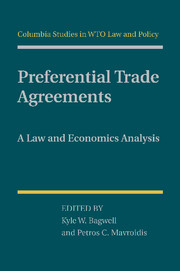Book contents
- Frontmatter
- Contents
- Contributors
- Introduction: The Law and Economics of Contingent Protection
- 1 Preferential Trading Agreements: Friend or Foe?
- The “Legalization” of GATT Article XXIV – Can Foes Become Friends?
- 2 Third-Country Effects of Regional Trade Agreements
- 3 Contingent Protection Rules in Regional Trade Agreements
- 3.1 Commentary on “Contingent Protection Rules in Regional Trade Agreements”
- 4 The Limits of PTAs
- 5 EU and U.S. Preferential Trade Agreements: Deepening or Widening of WTO Commitments
- Straightening the Spaghetti Bowl
- 5.1 Comments on “Beyond the WTO? Coverage and Legal Inflation in EU and U.S. Preferential Trade Agreements”
- 6 Labor Clauses in EU Preferential Trade Agreements – An Analysis of the Cotonou Partnership Agreement
- 7 Do PTAs Actually Increase Parties' Services Trade?
- 8 A Model Article XXIV: Are There Realistic Possibilities to Improve It?
- 8.1 Comments on “A Model Article XXIV: Are There Realistic Possibilities to Improve It?”
- Index
- References
8.1 - Comments on “A Model Article XXIV: Are There Realistic Possibilities to Improve It?”
Published online by Cambridge University Press: 03 May 2011
- Frontmatter
- Contents
- Contributors
- Introduction: The Law and Economics of Contingent Protection
- 1 Preferential Trading Agreements: Friend or Foe?
- The “Legalization” of GATT Article XXIV – Can Foes Become Friends?
- 2 Third-Country Effects of Regional Trade Agreements
- 3 Contingent Protection Rules in Regional Trade Agreements
- 3.1 Commentary on “Contingent Protection Rules in Regional Trade Agreements”
- 4 The Limits of PTAs
- 5 EU and U.S. Preferential Trade Agreements: Deepening or Widening of WTO Commitments
- Straightening the Spaghetti Bowl
- 5.1 Comments on “Beyond the WTO? Coverage and Legal Inflation in EU and U.S. Preferential Trade Agreements”
- 6 Labor Clauses in EU Preferential Trade Agreements – An Analysis of the Cotonou Partnership Agreement
- 7 Do PTAs Actually Increase Parties' Services Trade?
- 8 A Model Article XXIV: Are There Realistic Possibilities to Improve It?
- 8.1 Comments on “A Model Article XXIV: Are There Realistic Possibilities to Improve It?”
- Index
- References
Summary
Professor Davey has written a very interesting chapter on preferential trade agreements (PTAs). Such trade preferences are, by definition, restricted to members of the PTA, but not extended to other members. As such, prima facie, they violate the cardinal principle of nondiscrimination among members of GATT/WTO as enshrined in the Most Favored Nation (MFN) clause of Article I.1 of the GATT agreement of 1947 (hereafter GATT, 1947). This agreement was incorporated (with subsequent amendments) as GATT (1994) as part of the multilateral agreements signed in 1994 that concluded the Uruguay Round of Multilateral Negotiations, among which the agreement to found the WTO with effect from January 1, 1995, with the then set of contracting parties (CPs) of GATT as founder members, was one. However, the original CPs of GATT had explicitly exempted from the MFN clause, albeit under certain conditions specified in Article XXIV, namely customs unions (CUs) and free trade areas (FTAs). They also grandfathered and capped the then existing trade preferences (such as those of the UK, France, the United States, and a few other CPs) through Articles I.2–I.4. While recognizing “the desirability of increasing freedom of trade by the development, through voluntary agreements, of closer integration between the economies of the parties to such agreements,” they also recognized that “the purpose of customs union or a free trade area should be to facilitate trade between the constituent territories and not to raise barriers to the trade of other members with such territories” (Article XXIV:4).
- Type
- Chapter
- Information
- Preferential Trade AgreementsA Law and Economics Analysis, pp. 262 - 268Publisher: Cambridge University PressPrint publication year: 2011



